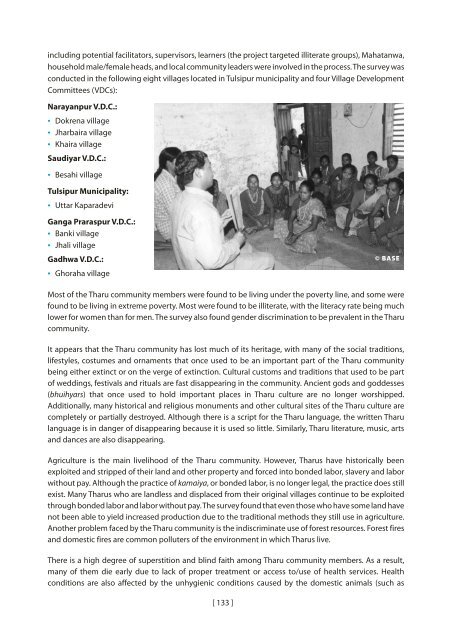Mother Tongue-based Literacy Programmes: Case Studies of Good ...
Mother Tongue-based Literacy Programmes: Case Studies of Good ...
Mother Tongue-based Literacy Programmes: Case Studies of Good ...
You also want an ePaper? Increase the reach of your titles
YUMPU automatically turns print PDFs into web optimized ePapers that Google loves.
including potential facilitators, supervisors, learners (the project targeted illiterate groups), Mahatanwa,household male/female heads, and local community leaders were involved in the process. The survey wasconducted in the following eight villages located in Tulsipur municipality and four Village DevelopmentCommittees (VDCs):Narayanpur V.D.C.:•••Dokrena villageJharbaira villageKhaira villageSaudiyar V.D.C.:• Besahi villageTulsipur Municipality:• Uttar KaparadeviGanga Praraspur V.D.C.:Banki villageJhali village••Gadhwa V.D.C.:• Ghoraha village© BASEMost <strong>of</strong> the Tharu community members were found to be living under the poverty line, and some werefound to be living in extreme poverty. Most were found to be illiterate, with the literacy rate being muchlower for women than for men. The survey also found gender discrimination to be prevalent in the Tharucommunity.It appears that the Tharu community has lost much <strong>of</strong> its heritage, with many <strong>of</strong> the social traditions,lifestyles, costumes and ornaments that once used to be an important part <strong>of</strong> the Tharu communitybeing either extinct or on the verge <strong>of</strong> extinction. Cultural customs and traditions that used to be part<strong>of</strong> weddings, festivals and rituals are fast disappearing in the community. Ancient gods and goddesses(bhuihyars) that once used to hold important places in Tharu culture are no longer worshipped.Additionally, many historical and religious monuments and other cultural sites <strong>of</strong> the Tharu culture arecompletely or partially destroyed. Although there is a script for the Tharu language, the written Tharulanguage is in danger <strong>of</strong> disappearing because it is used so little. Similarly, Tharu literature, music, artsand dances are also disappearing.Agriculture is the main livelihood <strong>of</strong> the Tharu community. However, Tharus have historically beenexploited and stripped <strong>of</strong> their land and other property and forced into bonded labor, slavery and laborwithout pay. Although the practice <strong>of</strong> kamaiya, or bonded labor, is no longer legal, the practice does stillexist. Many Tharus who are landless and displaced from their original villages continue to be exploitedthrough bonded labor and labor without pay. The survey found that even those who have some land havenot been able to yield increased production due to the traditional methods they still use in agriculture.Another problem faced by the Tharu community is the indiscriminate use <strong>of</strong> forest resources. Forest firesand domestic fires are common polluters <strong>of</strong> the environment in which Tharus live.There is a high degree <strong>of</strong> superstition and blind faith among Tharu community members. As a result,many <strong>of</strong> them die early due to lack <strong>of</strong> proper treatment or access to/use <strong>of</strong> health services. Healthconditions are also affected by the unhygienic conditions caused by the domestic animals (such as[ 133 ]

















